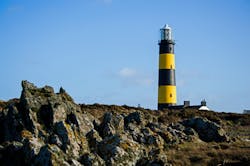LED opponents rally against conversion of lighthouse in Irish Sea
Objections are flaring up again in a long running battle to prevent a County Down lighthouse from converting to LED, with opponents claiming the digital light source would destroy the beauty of the light which they say would no longer cast its atmospheric loom across the Irish Sea.
Conversion from a 1000W filament source to a more energy-efficient 90W LED is set to begin in 2021 at the St. John’s Point Lighthouse on the eastern coast of Northern Ireland.
Campaigners, who five years ago used roadblocks to successfully stop an earlier attempt, are steeling themselves for more action.
“These people are ready to go again, they will not be stopped,” LED opponent Eileen Peters told the UK newspaper The Guardian. “The most important objection is the reduction in the quantity and character of the beam. It’s part of our heritage, the quality of our beautiful light.”
Referring to the Commissioner of Irish Lights (CIL), the body behind the replacement, Peters added, “It just shows what philistines they are.”
At issue is an optical phenomenon known as “the loom of the light,” in which particles of water vapor scatter light upwards so that it can be seen beyond the horizon. Opponents maintain that the LED would eliminate the effect.
Specialty SSL story: The LED street lights on this North Sea island are for the birds
But CIL director of coastal operations Robert McCabe said the proposed LED light would still cast a loom. “In reality, it’s very little change,” McCabe said. “The light picking up moisture in the atmosphere, like searchlights in war movies — none of that will change.”
The new lights would have a shorter range, at 18 miles compared to the current 25 miles. They would also have a blue-white tinge. Those facts drew ire from Hugh O’Donnell, who has a family history at the lighthouse.
“LED is too damn harsh and it doesn’t have the penetration range of the old light,” O’Donnell noted. “Shorter range, different color, harder to look at — it’s a mistake.”
But McCabe said LED technology would respect heritage while also slashing energy costs and removing a potentially hazardous mercury bath that the lighthouse currently uses to rotate the Fresnel lens. The CIL plans to replace the mercury with a mechanical bearing.
The CIL has already modified earlier plans. Following the 2015 roadblock, it dropped its intention to outright eliminate the revolving lens and sweeping beam with a static light.
Specialty SSL story: Turtles hatch to warm LEDs on Alabama’s gulf coast
But that’s not enough to placate the lighting traditionalists. St. John’s Point first lit up in 1844 by burning oil. It switched to coal gas illumination in 1875, to paraffin in 1908, and to electric lighting in 1957 on an auxiliary light and in 1981 on the main light.
CIL’s foes say that LED should not join that timeline. “It doesn’t represent progress,” said campaigner Peters.
CIL, which manages lighthouses in both Ireland and Northern Ireland, is currently soliciting bids for St. John’s Point. It plans to start procurement in 2021 and to complete the conversion in 2022.
MARK HALPER is a contributing editor for LEDs Magazine, and an energy, technology, and business journalist ([email protected]).
For up-to-the-minute LED and SSL updates, why not follow us on Twitter? You’ll find curated content and commentary, as well as information on industry events, webcasts, and surveys on our LinkedIn Company Page and our Facebook page.

Mark Halper | Contributing Editor, LEDs Magazine, and Business/Energy/Technology Journalist
Mark Halper is a freelance business, technology, and science journalist who covers everything from media moguls to subatomic particles. Halper has written from locations around the world for TIME Magazine, Fortune, Forbes, the New York Times, the Financial Times, the Guardian, CBS, Wired, and many others. A US citizen living in Britain, he cut his journalism teeth cutting and pasting copy for an English-language daily newspaper in Mexico City. Halper has a BA in history from Cornell University.





